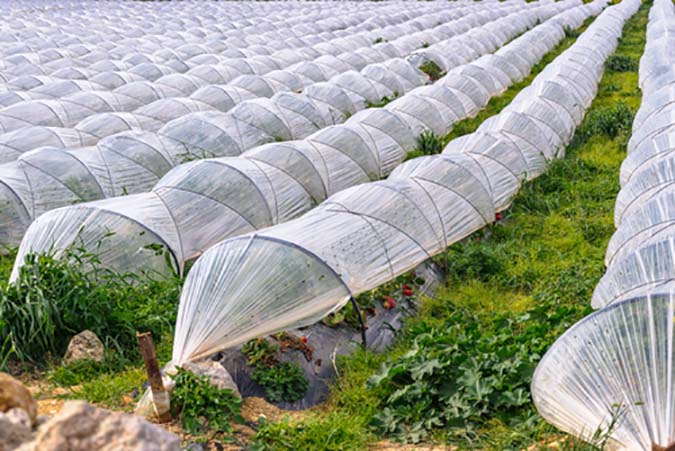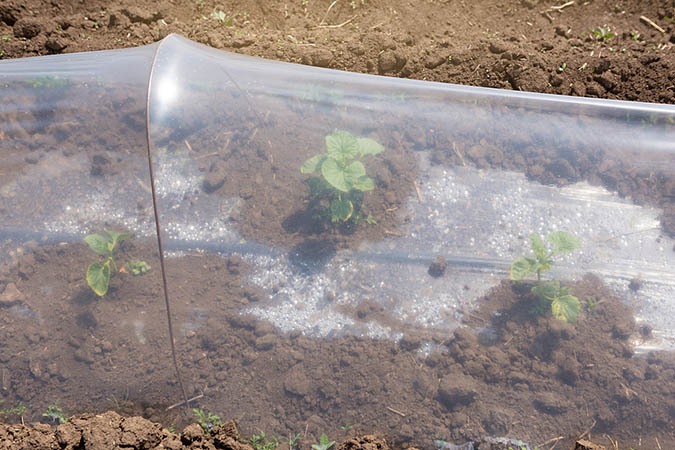Low tunnels are an inexpensive, DIY way to extend your growing season. Learn how to build a low tunnel that suits your climate and needs.
How to Build and Use a Low Tunnel for Inexpensive Season Extension
Want to eat fresh, homegrown greens all winter long? This video shows a cheap and easy way to extend your growing season into the winter months. (And if your garden soil is frozen right now, remember that you can use this method to extend your growing season on the other side of winter, too, so you can get a jump-start on your spring garden.)
When you build a low tunnel, you’re building a really simple structure. (Note that low tunnels are called by different names in different regions. I’ve heard them referred to as hoop houses, cloches, and cold frames. Those terms get the point across, but each of them technically refers to something else. So for the sake of clarity, we’ll call this a low tunnel.)
Best Materials to Build a Low Tunnel Frame
To build a low tunnel, you start with a structure that’s a simple series of hoops. I’ve seen people use PVC pipe, PVC electrical conduit, steel rebar, cattle panel, and flexible fiberglass rods (like tent poles) to build a low tunnel frame. In my opinion, the best option is PVC—unless you have one of the other materials on hand already. A 10-foot length of 1/2-inch schedule 40 PVC pipe typically sells for under $2, so it’s affordable. PVC electrical conduit is about the same cost, and it should last longer out in the elements.
You May Also Enjoy:
By popular demand, we’re offering our step-by-step, DIY Hoop House Plans for just $30! Click Here to Buy Today
“Top 5 Things to Consider When Building (or Buying) a Greenhouse”
My favorite method for securing the posts is driving a piece of rebar into the ground and fitting the PVC over the rebar, as is demonstrated in this video. (It’s comical to think that you could drive rebar 2 feet into the ground in my area, though. It’s solid rock down there, so we use pieces that are about 1 foot long, and we can usually get them about 8 inches deep.) I have also seen many people use pipe straps, screwed into the sides of their raised beds. I think the rebar method is better—especially if your beds are a few years old and the wood has started to break down. Also, the rebar method can be done on any bed or row, even if there is no frame.
The final element is the cover, and this is where I’ve heard a lot of debate about which material is best . . . .
Plastic vs. Cloth as a Low Tunnel Cover
There are two common options: plastic or cloth.
Plastic sheeting allows light to reach the plants, but it doesn’t allow for any air circulation or water penetration. Water may not be an issue if you’re protecting a bed that has drip irrigation installed. But because there is no air circulation, plastic is prone to overheating the tunnel on sunny winter days. If you use plastic, you need to remove or ventilate the tunnel appropriately to avoid smothering your plants with hot, humid air.
Cloth is a better option for air circulation and water penetration. Floating row cover is a cloth material made of woven synthetic fibers that allows hot air out and allows water in, while providing insulation and light penetration similar to that of plastic film. In my relatively warm and dry climate, cloth row covers work very well for low tunnels. Be careful about using old sheets and blankets in wet weather—those can absorb water, and they can actually cool the air as that water evaporates.
5 Considerations When Using a Low Tunnel to Extend Your Growing Season
A handful of tips and pointers:
• Climate: Take your climate into consideration when choosing the material you use to cover the tunnel. Where I live, I need to take advantage of every drop of rain that I get, so I use cloth instead of plastic. If you have abundant winter rains and you need to regulate the soil moisture, plastic might be a better option for you.
• Integrity: If you build a low tunnel that is very long, or if your garden gets a lot of wind in the winter, consider using an additional length of pipe across the top, lengthwise, for structural integrity. Fix it to the hoops using twine or zip ties, not pipe fittings.
• Staples: In the video above, they staple the plastic to the raised bed frame. I would skip that step, and use rocks or bricks to weigh the plastic down instead. You’ll extend the life of the cover and make it easier to ventilate on warm days.
• Lights: You can use a string of Christmas lights inside the tunnel for added warmth. If you do this, you will want to use the old-school incandescent lights. The newer LEDs are more efficient, but they don’t offer much warmth. In this case, you want less-efficient bulbs that use more energy and generate more heat.
• Survival Blankets: You can add a survival blanket on top of your cover for extra insulation on very cold nights. Face the shiny, aluminized side down, and remove the blanket to let the sun warm the soil again on the following day.
Check out “Frost Protection and Extending the Growing Season” from the Colorado Master Gardener Program and the Colorado State University Extension. They tested a low tunnel with 4-mil plastic sheeting, a survival blanket, and a 25 light string of C-7 Christmas lights. With all three of these measures in place, they consistently raised the temperature inside the tunnel between 18 to 30 degrees.
To see some additional creative ways to add heat inside a structure during the winter, read these two great articles from our writing contest. This one is technical: “Mad Scientist Works For Greenhouse Heating Independence Down To -25F.” And this one is practical: “Saving Heat in a Small Winter Hoop House.”
If you want to eat fresh, homegrown greens this winter, but you don’t want to build a structure, here’s a much smaller scale solution that you can put into place right on your kitchen counter: “Grow Sprouts and Microgreens Indoors All Winter Long.”
What Do You Think?
Have you ever built a low tunnel? What’s your favorite way to add or conserve heat in a low tunnel or other cool-weather gardening structure? Let us know in the comments below!
____________________
This is an updated version of an article that was originally published on November 23, 2015. The author may not currently be available to respond to comments, however we encourage our Community members to chime in to share their experiences and answer questions!
The Grow Network is a participant in the Amazon Services LLC Associates Program, an affiliate program designed to provide a means for our team to earn fees for recommending our favorite products! We may earn a small commission, at no additional cost to you, should you purchase an item after clicking one of our links. Thanks for supporting TGN!
____________________
Thanks to Natalie Donnelly, John Garlisch, and Nissa Patterson of New Mexico State University—Bernalillo County Extension Service for the nice video.
Thanks to David Whiting, Carol O’Meara, and Carl Wilson of the Colorado State University Extension for the PDF “Frost Protection and Extending the Growing Season.”










COMMENTS(5)
Great article, Michael! You are so skilled at finding new ways to look at things .
A suggestion for holding plastic sheets down: I live in an area where the wind gusts are more like explosive blasts. We tried high tunnels one year on seriously cheap. The plastic sheets were several feet longer than the tunnels. so I overlapped them at the bottom, rather like grabbing the ends of a shawl and crossing your arms over each other to keep the wind out. This pretty well covered over the gap on the ends. I tried logs, then rocks. Then by accident I noticed that a chunk of straw was the only spot that didn’t blast off. I laid several half sheaves of straw across the entire overlapped ends front and back. The ends stayed in place. My guess is that the wind may blow right through the straw, or that the straw is somewhat air permeable and the force of the wind is broken up enough to not lift the straw up.
Hi Sandy – What a nice compliment 🙂 And that’s a good tip about using straw to secure the ends of the tunnel – good info for anyone who is trying this in a windy spot!
Excellent idea! Low tunnels like that can help you grow plenty of leafy green veggies well into the colder months.
WE LIVE IN THE STATE OF INDIANA CAN I STILL DO THIS HERE AND WHAT CAN I PLANT IN THE FALL AND WINTER MONTHS THAT WILL GROW HERE THIS IS THE FIRST TIME THAT I HAVE EVER HEARD OF THIS OR SEEN THIS AND I LIKE IT I LOVE IT REALLY THIS IS SO COOL ; I CAN REALLY USE THIS KIND OF STUFF PLEASE KEEP SENDING ME EMAILS LETTING ME KNOW THINGS LIKE THIS PRETTY PLEASE . ALSO HOW CAN I GROW LOTS OF TOMATOES IN MY GARDEN AND CAN WE DO THAT IN THIS KIND OF THING HERE THAT I SEEN IN THE FALL AND IN THE WINTER ; I ALSO WOULD LIKE TO KNOW MORE ABOUT GROWING LEMON AND LIME MINI TREES IN PATS I HAVE TWO LEMONS AND I THINK I HAVE TWO LIMES THAT I HAVE IN 5 GALLON BUCKETS WITH LIDS ON AROUND THE PLANT SO WHEN I BRING IT INTO THE KITCHEN BY THE BACK DOOR TO GET LIGHT IN THE WINTER MONTHS I DID CUT A WHOLE AROUND THE PLANT ; AND I PUT AIR WHOLES IN THE LID ALSO AS WELL AS DRAINAGE WHOLE IN THE BOTTOM OF THE BUCKET TO GROW THESE LITTLE TREES I LOVE THEM ANYWAY I DID THIS SO THAT MY CATS DOES NOT PEE IN THEM AND KILL THEM I DO WANT A ORANGE TREE A SMALL ONE YOU KIND WHAT I AM TALKING ABOUT I JUST DON’T KNOW HOW TO SPELL IT A DWARF TREES I THINK THIS IS THE RIGHT WAY TO SPELL IT ANYWAY CAN YOU HELP ME HERE PRETTY PLEASE
IT DOES GET COLD HERE IN THE WINTER MONTHS SO ANY KIND OF HELP THAT YOU CAN GIVE TO ME WOULD BE NICE . IT IS HARD ON ME TO GARDEN BECAUSE I HAVE A SPINAL CORD INJURY AND I HAVE A LOT OF TOMATO PLANTS BY THE BACK PATIO I ALSO WOULD LIKE TO KNOW JUST HOW TO REALLY GROW
RHUBARB PLANTS I HAVE ONLY ONE PLANT I AM TRYING TO GROW THAT IT IS MY FIRST ONE ; HOW DO I GROW A LOT OF ONIONS THAT WILL GROW ? ALSO GARLIC I LOVE GARLIC IT IS GOOD FOR YOU !
ALSO HOW CAN I REALLY GROW LAVENDER I HAVE TRIED AND IT WOULDN’T GROW RIGHT I DON’T THINK I DID SOMETHING RIGHT AT ALL HERE WITH THIS PLANT .
ANYWAY I THANK YOU FOR YOUR TIME AND HELP I REALLY LOVED WHAT I SEEN HERE I DON’T KNOW BUT CAN I PRINT THIS ALL OUT SO THAT I CAN READ IT AS I AM MAKING THIS STUFF AND LEARNING IT PLEASE THANK YOU AGAIN FOR YOUR TIME & HELP PLEASE HAVE A NICE DAY & NIGHT .
PLEASE REPLY BACK TO ME IF YOU WOULD BE SO KIND AS TO DO SO THANKS
Great article. Nice cost effective way to extend the growing season. Especially like the tip of using straw to hold the plastic down.